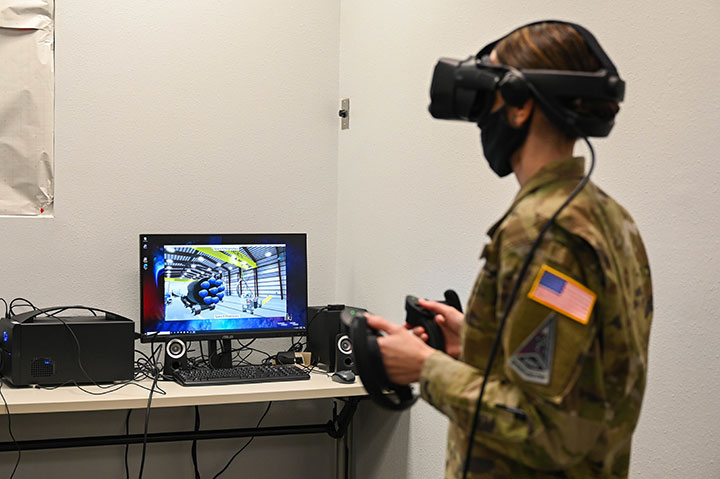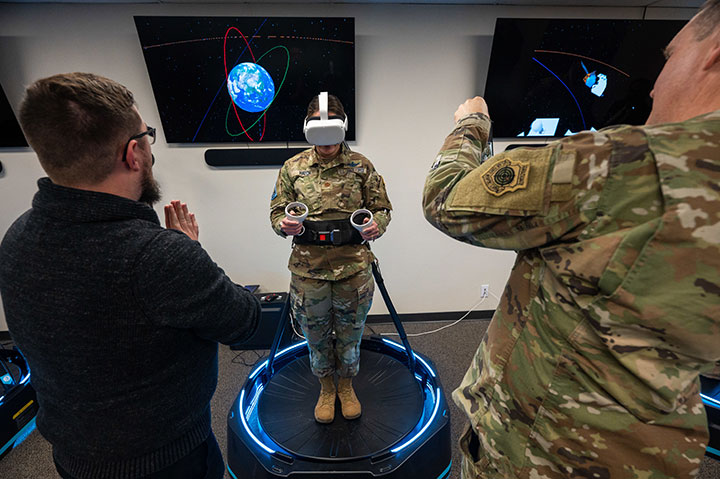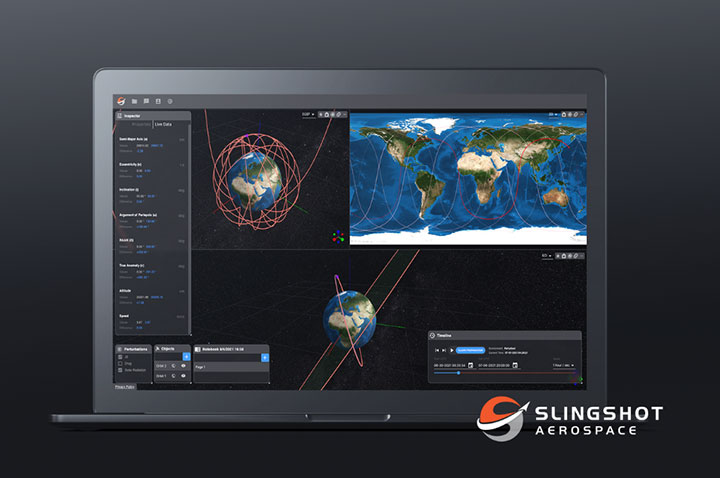 A Space Delta 2 senior enlisted leader experiences a virtual simulation at Cape Canaveral Space Force Station, Fla., April 20, 2021. (Source: U.S. Space Force/Airman 1st Class Thomas Sjoberg)
A Space Delta 2 senior enlisted leader experiences a virtual simulation at Cape Canaveral Space Force Station, Fla., April 20, 2021. (Source: U.S. Space Force/Airman 1st Class Thomas Sjoberg)
When the U.S. Space Force launched its sixth next-generation “GPS III” satellite on Jan. 18, 2023, some people watched from the ground. Others, however, watched from a place that many have heard about but few have yet to actually visit: the metaverse.
To showcase the cutting-edge design and technology behind Global Positioning System III Space Vehicle 06 (GPS-III-SV06)—otherwise known as Earhart—Arizona State University’s Thunderbird School of Global Management created the Thunderverse, an interactive virtual environment that mimics the features of a futuristic space station.
For the Space Force, it was a taste of things to come. Last year, the service announced plans to develop its own version of the metaverse. Called the SpaceVerse, it will be an “integrated mission environment to collaborate, co-create and operate digital capabilities, models, simulations and twins from any user device,” Space Force Chief Technology and Innovation Officer (CTIO) Lisa Costa explained at the time.
The SpaceVerse is likely still years away. In the meantime, Earhart’s virtual satellite launch was a novel way for the Space Force to connect with future recruits and showcase the technology to the American public at large, according to Travis Cloyd, global futurist, professor and senior fellow at Thunderbird.
“Traditional storytelling on screens—theater screens, mobile screens, TV screens—is a very passive experience,” Cloyd told Constellations. “But with the metaverse, the user goes into different simulations, different environments and different worlds. It’s a new way of storytelling that’s more engaging, more immersive and more interactive.”
In the space domain, especially, the metaverse offers the ability not only to tell stories, but also to advance missions, develop new capabilities and even protect against space-related threats.
Open Standards Are Key
Although the SpaceVerse could become a powerful tool in the Space Force’s arsenal, its success hinges on interoperability and open standards, according to Michael Torres, SpaceVerse architect and chief of digital infrastructure at the Space Force’s Chief Technology and Innovation Office.
“Players in industry … should come together and focus on a common, open-standards exchange that allows for the unification of data in real time in a ‘verse of verses’ environment,” Torres said during a webinar hosted by the National Training & Simulation Association (NTSA). “You can’t have a ‘verse of verses’ if they’re all the same. The goal is to drive open standards for exchange, and we need to come together as a community to create a universal verse standards suite.”
An example of open standards in action is the deconflicting of launch activities at spaceports, which are increasingly congested thanks to the growth of the commercial space industry. With open standards, collaborators and competitors across government and industry can share data and simulations in the metaverse to create a common operating picture that’s synchronized across multiple stakeholders using multiple systems.
 A hands-on demonstration of a virtual reality immersion at the National Security Space Institute, Colorado Springs, Colo., Nov. 8, 2022. (Source: U.S. Space Force/Ethan Johnson)
A hands-on demonstration of a virtual reality immersion at the National Security Space Institute, Colorado Springs, Colo., Nov. 8, 2022. (Source: U.S. Space Force/Ethan Johnson)
“Having a common language of describing the virtual environment allows for many simulations to collaborate together in one ecosystem,” Tim Woodard, senior solutions architect at NVIDIA, explained during NTSA’s webinar.
As an example of an open standard, Woodard cited the Universal Scene Description (USD) framework for exchanging 3D graphics. “With the metaverse being the next iteration of the internet, you can think of USD as HTML. It’s a common language we can use to exchange information between applications, and it allows for a desegrated architecture [that allows] multiple applications to work together to provide a complete picture of what’s going on.”
Creating a ‘Digital Thread’
Ultimately, the SpaceVerse is a link in a larger digital engineering chain—or what the Space Force calls the “digital thread.”
The concept is simple: Whenever the Space Force builds or acquires a physical asset like a satellite, it will create a digital record that follows that asset throughout its lifecycle, providing an integrated source of asset-related data that reaches across functions and siloes. That digital record encompasses the requirements, parts and control systems that make up the physical asset, which can be utilized to create digital twins of the asset inside the SpaceVerse.
“If we do this right, we can take everything from force design to requirements … to acquiring the capabilities and testing the capabilities and training our guardians on those systems—all using the same digital thread,” Space Force Chief of Space Operations Gen. Jay Raymond told an audience at the Air and Space Force Conference. “That’s nirvana.”
Again, open standards play a key role. Because the Space Force wants to leverage commercial technology, the digital thread must be able to reach across vendors to enable the creation and interaction of digital twins that are interoperable and system-agnostic.
“We want to use a commercial standard for digital twins, and we want to be able to share information with our allied partners, with industry,” Costa told Inside Defense. “Having an international standard for digital twins, for visualization of them, for information sharing between them is really very important to us.”
High-Tech Training
The Space Force took an initial step toward creating the SpaceVerse last year by awarding a $25 million contract to Slingshot Aerospace, which is creating a digital replica of the space environment for use in training and wargaming. Guardians will use VR headsets and other metaverse technologies to access that digital replica. Inside the program, they’ll be able to complete simulations that reproduce real-life missions and scenarios—including events that haven’t actually happened yet but someday could, like a state-sponsored cyberattack against a U.S. satellite, or even a physical attack using anti-satellite missiles or lasers.
 Slingshot Aerospce was awarded a contract with Space Systems Command to deploy a next-generation space training product. (Source: Slingshot Aerospace)
Slingshot Aerospce was awarded a contract with Space Systems Command to deploy a next-generation space training product. (Source: Slingshot Aerospace)
Such simulations have proven effective in preparing warfighters for high-stress situations. The format is also likely to be popular in attracting and retaining the roughly 86% of U.S. airmen and guardians between the ages of 18 and 34 who identify as gamers.
“There is an issue retaining military personnel due to the training crisis. The metaverse and AR will help us out of the hole,” said Peter Squire, program officer of human performance, training and education at the Office of Naval Research.
Funding the Future
Building an interoperable SpaceVerse won’t be easy. Although the technology is there, the stakeholder support in some cases isn’t, Torres said during a panel discussion at the U.S. Geospatial Intelligence Foundation’s GEOINT Symposium.
Stakeholders who associate it with its gaming origins often assume that the metaverse is about “little dragon avatars running around little digital block worlds,” noted Torres. In reality, the metaverse is about “the integration of environments” and “the ability to use open standards to do real-time exchange of data” so users can “share and operate in a co-simulated, distributed, synthetic environment.”
Despite some initial skepticism, Space Force leadership appears to be coming around to the idea: The service’s fiscal year 2024 budget proposal seeks $17 million for SpaceVerse research and development. If Congress approves the funds, the Space Force will be one step closer to achieving what it calls “a new, resilient and common mission environment to simplify space operations from 2D to immersive experiences to improve warfighting against near-peer threats.”
Concluded Torres, “What we’re trying to achieve … [is] being able to allow for live, dynamic, operational and training experiences across any platform, using any technology, for any purpose.”
Explore More:
Podcast: Digital Service, Building an Open Architecture and the Critical Role of Industry
Simulators Needed: Space Force Seeks Funding for Digital Training Ranges
Hollywood Tech Is Helping Solve Big Data Problems in Space
